But the river trade changed, and the fortunes of economy passed Cairo by. Today the town is a sad shell of its former self, its glory long wilted.

This is Commercial Street, the main shopping street of the town back in the day. I arrived about 4:30pm on January 2nd, a Friday. The street looked like this: empty. Deserted. Not a soul was to be seen. No cars. No lights. No people. Nothing.
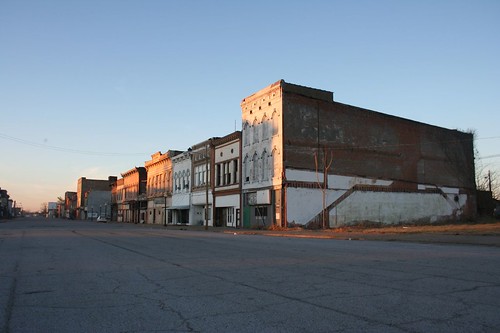
Three or four solid blocks of Victorian commercial buildings have been left to rot. Some are literally collapsing onto the sidewalk. Others are gutted, every piece of glass shattered.

Nearby Washington Avenue is doing better, and has most of the city's businesses. It is a more suburban-styled street, but has some architectural gems.
The town's struggles with racism are legendary. In the late 1960s, the city's black community organized a boycott against segregated white-owned businesses. The owners so adamantly refused to give in that one by one they simply went out of business, over the course of a few years.
Those days may be past, but the city's struggles continue. The town's fall probably has as much to do with the overall centralization of river traffic as any problems created by racism. Cairo isn't much of a port anymore. The Interstates have passed it by, and there isn't much room to grow. The Bunge Corporation maintains a soybean processing plant there, and railroads still loop around and through the town, so little Cairo isn't entirely off the economic map. But there is little else.
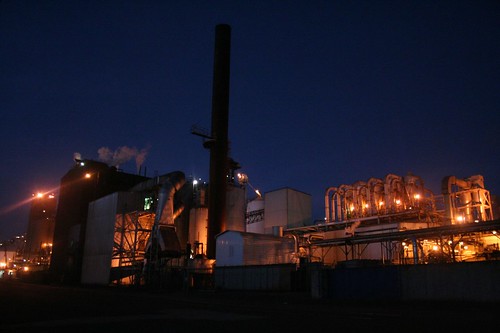
Cairo's geography is unfathomable. Sited on a narrow wedge of land between the two rivers, it is perpetually in danger of being washed away by the whims of the mighty rivers. Thus a huge levee rings the entire town. To the south, one simply drives over it. But to the north, where land is lower, a gargantuan metal gate descends to close off a tunnel through the railroad embankment when flood waters rise.
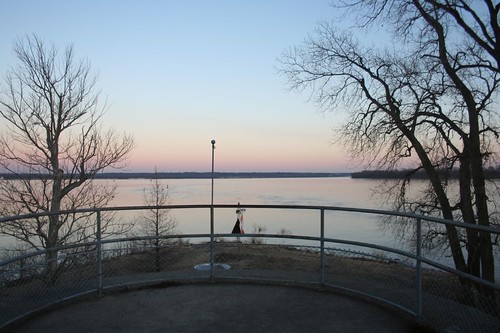
At Fort Defiance Park, one can literally stand at the confluence, the exact point where two thousand miles of river join together. The two channels unite to form a river nearly a mile in width. The view is awe-inspiring. The water was nearly level with the park land on the evening of my visit, an obvious warning of the rivers' power.
Two mighty bridges cross the rivers, connecting the city to Kentucky to the east, and Missouri to the west. They carry two-lane roads, long surpassed by I-57 to the west.
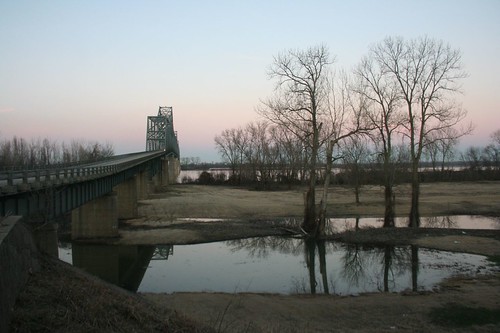
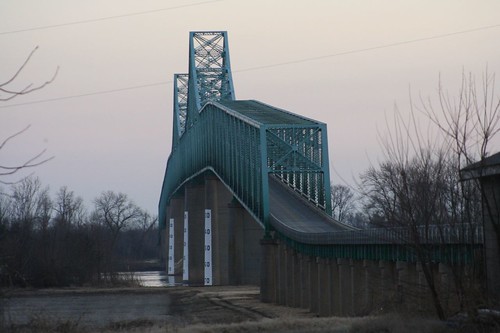
Traces of Cairo's glory days remain. Scattered churches, mansions, and public buildings have been restored and maintained.

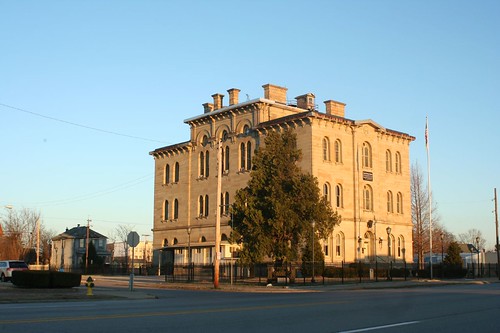
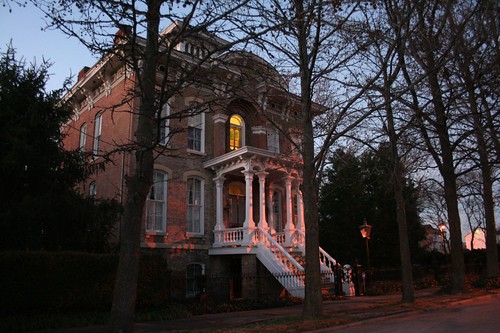
But they sit in a landscape wrought with the physical signs of abandonment, of despair: empty lots, reclaimed by forest. Wrecked and ruined buildings. Streets leading nowhere.
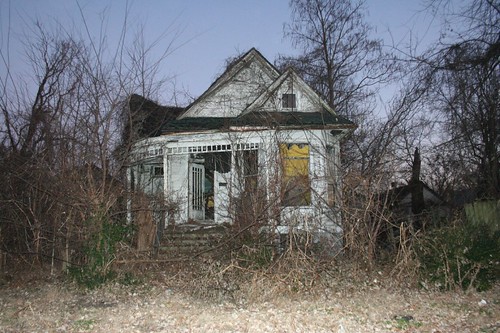
It's hard to imagine a bright future for long-suffering Cairo, but there remains a peculiar beauty to its ruins, amplified by its precarious place upon the fickle rivers.
Links:
* More photos
* Cairo, IL at Wikipedia
* Mississippi River web site page on Cairo.
21 comments:
I read with great interest your description of your trip to Cairo. I visited Cairo about 5 years ago in the course of doing some genealogical research and found it much the same. I experienced the same sorrow and regret that such a one-time vital community with many fine homes and buildings had decayed to the extent that it had.
I did find two bright spots. The townsfolk have, on their own, tried to preserve the old federal court house, turning it into a charming museum about Cairo (including Cairo's claim to fame as the locale in which author Edna Ferber penned the novel that Jerome Kern turned into the musical Showboat). My heart went out to the elderly guardians of this treasure and the tenderness with which they tried to preserve it. The other bright spot was the old public library, another charming building -- warm, receptive and quite busy.
I like your blog, especially the way that you're monitoring old north St. Louis (in which I too take a special interest). Keep up the good work.
The federal courthouse, which people in Cairo call the Custom House, was designed by the same man that did St. Louis's Old Post Office.
Why didn't you get out and talk to residents? You and people like you photgraph the ruin and don't ever stop to knock a door. You might lean something
A better question might be, how can I get the time and money that would be required to perform the sort of intensive documentation you're describing? I'm open to donations if that's what you're offering!
Another question might be, what exactly did you expect to find on a blog that's explicitly about architecture?
And stll another question might be, why don't you do it? The internet's big enough for both of us.
If you don't like these questions, you can instead consider this: I drove from Memphis like a madman for over two hours to reach Cairo before the sun dropped. I had less than 60 minutes of daylight to see the whole town, and I had to get back to Chicago the same night, some 6 hours up the road. You might therefore see why I didn't linger to chat up the locals.
Sorry if I'm acting snippy, Anon, but you've hit a real personal sore spot. Documenting these buildings and towns and cities is something I do in my spare time, for free. Nobody pays me for my time and labor and web hosting. I do this out of love. And what you see online is only a fraction of what I'd really like to do, if I had the time and resources. I squeeze out what I can, when I can, as best I can.
I would LOVE to find out the story behind every last building, but that takes time and money, over and above what I'm already putting out just to document the architecture. So to come marching in and suggest that I'm not doing my hobby correctly, and that I need to spend even more pro bono time on it, is, frankly, pretty obnoxious and more than a little presumptuous.
Thanks for the lovely post. I, too have ancestors from the area and am saddened to see its history and beautiful architecture fading. Here's hoping the younger generation will take interest and help to rebuild it.
Unfortunately, Cairo is not the only small city that suffers from a combination of lost industry and mass suburbanization. People tend to think that only large cities like St. Louis and Chicago suffer from abandonment and rotting away of architecture, but I think small towns and cities get hit worse, because often the money is not there to save important buildings, and unfortunately community support is not as fervent to recognize good architecture. Drive up the road a spell and check out Vandalia, Illinois for a similar situation. Effingham, Illinois (on your way to Chicago) has a gorgeous art deco-style theater in their downtown that is in a state of disrepair. But the standard of living near the center of town in these cities is not nearly as good as the new subdivisions built in former corn fields, so they are abandoned and no one seems to mind.
Thank goodness someone is taking the time to do what you are doing before we have lost. I think to myself about these wonderful buildings, especially places like the Ambassador in St. Louis and think of a quote about the Garrick in Chicago before it was torn down:
"This building is part of the cultural inheritance of the nation and does not belong to individuals to destroy. "
Amen!
The smaller white building on the left in your first photo burned last week. Many of the others are gone as well, so it was good to find these photos of them before they were lost forever.
We just bought a 112-year-old house and moved to Cairo, so people are still coming here, and hope still springs eternal that some of the architecture that isn't on Millionaire's Row can be saved.
And, by the way, the buildings may look dismal but the people aren't. : )
Dear Sir,
Thank you for posting these pictures. Cairo was my home town. I was searching the WEB for photos of Cairo taken back in the 1960's in hopes of finding a picture or two of my Grandfather's store so I could reminisce and share them with my children. Back in the early 60's, my Grandfather owned a grocery ( Buddy's Buy-Low Market ) across the street from The Showboat restaurant at the corner of 10th St and Hwy51. Unfortunately, the building was torn down and replaced with a soulless utilitarian structure in the early 70's. I vaguely recall living there in an apartment above the store and later for a short time, in an apartment (owned by the Dichmeyer Sisters) just behind the store. I also recall we lived across the street from the park on Highland Ave near Magnolia Manner. There was too much tension in Cairo so my family re-located the store to Urbandale ('65-66 ) and about a year later my father bought the store and operated it until late '68. My Mother owned and operated a small restaurant ( The Diner ) until we moved to Florida in the fall of '68. There is a silhouette on one of the buildings in one of your photos which I believe is outline of where my Mother's diner, which was attached to an adjacent building, was located ( 2nd photo down: white wall with black outline ). My Mother's diner was an interesting facade: it was constructed out of an old street car and very tiny and with that said, I can remember it being almost impossible to maneuver past customers during lunch rush hour. I recall many of the business building that are now abandoned or worse, alive and well as I played in and around the Commercial Ave and Rail Road St. vicinity during afternoons after school. I recall " The Gem " movie theater and my Dad taking me to see GoldFinger and Thunderball, and later, Bonnie and Clyde and going to Saturday afternoons matinees with my cousin to see many of the " beach-blanket " movies of the time. As a child, it was a magical place. As an adult, I'm sure Cairo presented ( and continues to present ) itself with more than its far share of challenges.
I agree that with such notable architecture and locale, why should the place be such a wreck but, such is the case. No jobs as a result of short sided planning and small mindedness have left it a burned-out hulk rather than the quaint flower it could be. Such a pity. Sincerely, Jay Horton
I absolutely love this blog! I found your site many years ago when you had first posted photos and documentation from the Northside of St. Louis. I think it was part of a college thesis or something?
Either way, I was living in NC or Tampa (can't remember) and had never been to St. Louis. It was one of the most fascinating series of photos I think I had ever seen and helped inspire me to become a photographer.
Since then I've always been fascinated by abandonment and blight but have never ventured out to shoot photos of buildings in my region. I'm glad you take the time to do it.
This series from Cairo is amazing. I can't believe some of those buildings have just collapsed and no one has done anything. It almost looks like a war zone.
And despite what the one person said about talking to residents, I think it's honorable that you even take the time to visit these small places that are literally rotting away. Thank you!
I was born in Cairo in 1938, where my father was in advertising (among other assignments) for what was at the time the Cairo Evening Citizen. I still have the dummy front page the Citizen put out for my birth. It is so sad to see the condition of the town now. Back when we lived there, it was a city of around 11,000 with parks, a hospital (St Mary's) where I was born, a gorgeous Episcopal church (Church of the Redeemer) where I was baptized, city swimming pool, a daily paper, and lovely homes. We lived in a rented house at 635 27th Street. I wonder if it has survived and what condition it's in nowadays.
Dear Robert, I stubbled across your site just looking for info on Cairo. I live in Wickliffe (just across river). My paternal grandparents were from Cairo so I consider this my home as well as the farm I live on in Wickliffe.
My grandfather Tom VanCleve owned Cade's Florist on 8th St. When I was little I thought this was the "Big City"! I was born in 1969. My parents were young and in the hey day of the juke joints that had long been going strong before the 60s! According to my KY grandmother - HER mother (my GREAT grandmother)went to Cairo on the ferry to have a "schooner" of beer with the girls at the historial bar - Smith & Groves!!! Can you believe that!?! How brazen! Later in life I drank "schooners" in the SAME bar - but we called the large mugs of beer "Fish Bowls"!!!
I have heard many stories over the years. My grandmother from the historical Cairo is 92 and still has a great memory. She still has the home her dad built on Holbrook. I always loved Christmas at this house! I loved the seasonal visits to Millionaire Row. There's a grandieur that Riverlore and Magnolia Manor still try to display (even to this day) - though these strong and beautiful mansions have weathered many trying years.
I have often thought about relocation programs and other hair-brain ideas for this town, but feel that I alone can't do anything about it. Hopefully, one day it will return to the great town it once was and deserves to be again!
Sincerely,
Angela VanCleve
Great pictures, thanks for posting!
Angela-I'm curious, what streets make up Millionaire Row? Is it Washington Ave.?
The pictures are so contradictory. It's like even when those buildings are falling down, they are still screaming to live!
Thanks again for your blog!
Back in 1959 halfway thru 1962 I was stationed at Ft. Campbell, KY with the 101st Airborne Division. Several of us troopers would go to Cairo on a weekend pass about once a month. Seems there was a "Club 18" where we would go to meet girls. I really liked that old town. Seems the population back then was about 9 or 10K. There was a girl by the name of Vivian Tulos, I wonder if she might still be there, guess she would be close to 70 now. Oh well all that's long, long ago. Too the good times past.
Back in 1959 halfway thru 1962 I was stationed at Ft. Campbell, KY with the 101st Airborne Division. Several of us troopers would go to Cairo on a weekend pass about once a month. Seems there was a "Club 18" where we would go to meet girls. I really liked that old town. Seems the population back then was about 9 or 10K. There was a girl by the name of Vivian Tulos, I wonder if she might still be there, guess she would be close to 70 now. Oh well all that's long, long ago. Too the good times past.
Thank you so much for your photos and words; they are much needed to help preserve the memory of Cairo.
I was born in Cairo in the old St. Mary's hospital in 1956, but my parents lived across the river in Ballard County, Ky. I grew up in Kentucky and never thought much about Cairo -- though my friends and I visited a bar for pizza and beer in my late teens. I've never tasted beer or pizza as good since.
I read mention this week of Cairo in Neil Gamon's "American Gods," where a portion of the book is set. I had never seen the hospital where I was born, and had hoped to find its history and location online. It was so disappointing to discover that it was demolished decades ago.
It was sadder still to realize how little of Cairo was left. In the 1970s, when I still visited, it still seemed a lively place.
I live in Louisville now, but the next time I'm in the area, I intend to explore Cairo and preserve as much in my memories and photos as I can.
I also was born at St Mary's in 1950. I've searched years ago trying to find word of the old building, or perhaps a picture, but I guess that history is all gone now. But thanks 'Bill Wolf', for bringing this to my attention.
I was in the 101st at Ft Campbell KY and used to go to Cairo a lot and visited Club 18. I met a girl there named Sandy Reichert. I used to visit her family sometimes on weekends and they were kind enough to put me up for the weekend. I can remember helping her father Roy put up fence posts and then visiting Club 18. Its so disappointing to see whats happened to Cairo but its been a long time.
👍🏾
Great job, Robert and enjoyed your comments and the photos. You hit the nail on the head with your comments. Keep up the good work.
👁
Post a Comment